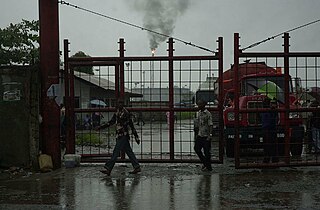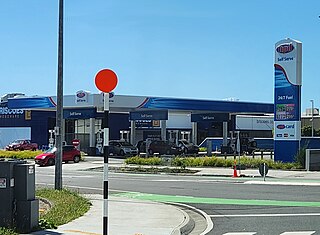
Think Big was an interventionist state economic strategy of the Third National Government of New Zealand, promoted by the Prime Minister Robert Muldoon (1975–1984) and his National government in the early 1980s. The Think Big schemes saw the government borrow heavily overseas, running up a large external deficit, and using the funds for large-scale industrial projects. Petrochemical and energy related projects figured prominently, designed to utilise New Zealand's abundant natural gas to produce ammonia, urea fertiliser, methanol and petrol.

Petroleum products are materials derived from crude oil (petroleum) as it is processed in oil refineries. Unlike petrochemicals, which are a collection of well-defined usually pure organic compounds, petroleum products are complex mixtures. Most petroleum is converted into petroleum products, which include several classes of fuels.

Singapore Petroleum Company Limited, in short SPC, is a Singaporean multinational oil and gas company. It is involved in the exploration and production of petroleum, refining, trading and petroleum product distribution.

Kochi Refinery Limited (KRL) is a crude oil refinery in the city of Kochi in Kerala, India. It is the largest public sector refinery in India with a production capacity of 15.5 million tonnes per year. Formerly known as Cochin Refineries Limited and later renamed as Kochi Refineries Limited, it was acquired by Bharat Petroleum Corporation Limited in the year 2006. The refinery is situated at Ambalamugal, around 12 km (7.5 mi) east of the city centre.

Naftna Industrija Srbije is a Serbian multinational oil and gas company with headquarters in NIS building, Novi Sad, Serbia. NIS is one of the most profitable companies in Serbia and one of the largest domestic exporters. It employs around 11,000 people in Serbia and the region. As of May 2022, Gazprom Neft is the largest shareholder with 50% of NIS shares, followed by 29.87% owned by the Government of Serbia, 5% owned by Gazprom and rest by minority shareholders.
Marsden Point is a broad, flat peninsula that is the southern head of the Whangārei Harbour entrance on the east coast of Northland, New Zealand, 30 kilometres (19 mi) southeast of the city of Whangārei. It is the location of Marsden Point Oil Refinery and the Northport cargo port.

Coryton Refinery was an oil refinery in Essex, England, on the estuary of the River Thames 28 miles (45 km) from central London, between Shell Haven Creek and Hole Haven Creek, which separates Canvey Island from the mainland.
The Marsden Point Branch is a 19 km (12 mi) branch line railway, which is to be built in the Northland Region of New Zealand's North Island. It will diverge from the North Auckland Line at Oakleigh, south of Whangārei, and serve Northport at Marsden Point. The proposal has existed since the 1970s and land for the rail corridor is being actively purchased.
Northport is a commercial sea port at Marsden Point, at the entrance to the Whangarei Harbour in Northland, New Zealand, located next to the Marsden Point Oil Refinery. It is a naturally deep-water port, with a maximum depth of 14.5 metres. It is the northernmost multi-purpose port in New Zealand, and the closest port to the majority of New Zealand's international markets. It is about 100 km north of the Auckland Northern Motorway, and around 75 nautical miles north of the Port of Auckland.
Western Refining, Inc., is a Texas-based Fortune 200 and Global 2000 crude oil refiner and marketer operating primarily in the Southwestern, North-Central and Mid-Atlantic regions of the United States. Western Refining (WNR) has been publicly traded on the New York Stock Exchange since January 2006 and is the fourth largest publicly traded independent refiner and marketer in the nation.

Grangemouth Refinery is an oil refinery complex located on the Firth of Forth in Grangemouth, Scotland, currently operated by Petroineos.

The BPRefinery (Kent) was an oil refinery on the Isle of Grain in Kent. It was commissioned in 1953 and had a maximum processing capacity of 11 million tonnes of crude oil per year. It was decommissioned in August 1982.

The oil and gas industry in New Zealand explores and develops oil and gas fields, and produces and distributes petroleum products and natural gas.

The Tema Oil Refinery (TOR) is one of two crude oil refineries in Ghana. In 1977, the Government of Ghana became the sole shareholder. The name of the refinery was changed to the Tema Oil Refinery in 1991. The refinery was first named the Ghanaian Italian Petroleum Company (GHAIP).

The Port Harcourt Refining Company,, is a Nigeria-based oil and gas company primarily specializing in the refining of crude oil into petroleum products. It is headquartered in Port Harcourt metropolitan area of Rivers State, southeastern Nigeria. The company is a subsidiary of the Nigerian National Petroleum Corporation (NNPC).
Cnergyico Pk Limited is a Pakistani petroleum company which is a subsidiary of the Mauritian company Cnergyico Industries Incorporated. The company is vertically integrated across the oil refining and marketing industries, notable for being the only petroleum company in Pakistan to own and operate a crude oil terminal. Cnergyico operates Pakistan’s biggest oil refinery in terms of nameplate capacity, the largest capacity crude oil storage tanks in the country, and a network of petrol pumps.
The Indeni Petroleum Refinery is an oil refinery in Zambia's industrial city of Ndola.
Manufacturing in New Zealand contributed $23 billion (12%) of the country's gross domestic product and directly employed 241,000 people in 2017, while manufactured goods made up 52% of the country's exports by value. The food and beverage subsector alone contributed 32% of manufacturing's GDP and 71% of exports.
The Lobito–Lusaka Oil Products Pipeline, also Angola–Zambia Oil Pipeline (AZOP), is a proposed pipeline to transport refined petroleum products from Angola's port city of Lobito to the city of Lusaka, the capital of Zambia. Various parties in Angola and Zambia have signed memoranda of understanding (MOUs) about the subject in the past, one in 2012, and another one on 29 April 2021.

NPD, short for Nelson Petroleum Distributors, is a New Zealand family-owned budget fuel distributor. It distributes Mobil fuels and Castrol lubricants, and started business in the 1960s. It is based in Nelson. As of August 2021, NPD has 96 petrol stations, most being in the South Island. According to a study from the Commerce Commission, NPD "appeared to have the most impact on the oil majors' prices". As of May 2020 it has 150 staff.












